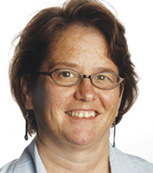- Title Page
- Introduction
- No Child Left Behind
- School Choice in Chicago
- A Beat Reporter Goes Deeper
- Going In Blind
- First Day, First Twist
- Beginnings of a Theme
- Behind the Scenes
- First Month at Stockton
- Obstacles
- From Stockton to Attucks
- Salvaging a Story
- The Projects Team
- Third Chapter?
- How to tell her?
A Beat Reporter Goes Deeper

Stephanie Banchero.
©
Chicago Tribune
By the summer of 2003, the Tribune ’s Banchero found herself wondering about the NCLB choice provision. How successful was it? What did it mean for the children it was meant to help? Once an aspiring teacher, Banchero had spent well over a year writing mostly about the NCLB’s policy implications. Now she found herself drawn to a different kind of story. “I wrote a lot of the national [stories about] ‘this is what’s going on with No Child Left Behind,’ sitting at my desk, talking to government officials, talking to teachers, but not really getting into the classroom and saying okay, what does it mean on the ground?” she says.
Banchero had one idea for how to answer her question: find a dedicated student transferring to a good school from a failing one, and closely track the child’s progress for an entire school year. This would mean immersing herself in the child’s life for a long period of time, and eventually writing a feature-length story. Banchero, a daily beat reporter, had never taken on such a lengthy assignment. Such an article would mark a significant departure from her usual coverage of education policy and local schools.
Uncertain whether she should even propose the story to her editor, Banchero turned for advice to her close friend and Tribune colleague, Cornelia Grumman , a Pulitzer prizewinner who wrote about education in the paper’s editorial pages but was on maternity leave. Banchero also approached Louise Kiernan, another colleague and Pulitzer winner, who was known, Banchero says, as “the writer at the paper.” Kiernan had done long narrative pieces of the type Banchero was considering. Both Grumman and Kiernan encouraged her to pursue the story. “It was a really good idea,” Kiernan recalls. “[Banchero] had taken this fairly arcane and complex and difficult-to-understand piece of legislation, and isolated one element of it, and then further isolated it into the story of one person. It had a lot of potential.” [1]
Yes, no, maybe . Just before the start of the 2003-2004 school year, Banchero sent a memo explaining the idea to her direct editor at the Metro desk, Kaarin Tisue. Tisue, however, was a daily editor; she did not normally assign or supervise long-form enterprise projects. “I was leading the paper’s education team only on a temporary basis,” Tisue says.
I was supervising multiple reporters and had many other simultaneous editing duties. I liked Stephanie’s story idea and gave her the go-ahead to pursue [it], but I was never sure if I was going to land the story or if it would be another editor. [2]
It was not common for a beat reporter to take on a long-term project. Among other costs, that would mean one less reporter for daily stories. Tisue told Banchero she could start investigating, but did not take her off the daily beat. Nor could she provide Banchero with much editorial oversight on this project.
“It’s not unique to the Tribune ,” says Grumman. “They’re just focusing on getting the next day’s paper out… [so] to present them with a large project in a newsroom culture is tough on an editor because all they see is the loss of a productive reporter.” [3] Banchero also recognized that her pitch was not well developed: “I wish I [could say] I had this grand plan… [But] I had absolutely no idea what was going to happen or what I was going to do.”
With encouragement from Grumman and Kiernan, Banchero decided to take advantage of the situation: She hadn’t gotten a yes, but no one had said no. While Banchero would have limited editorial oversight inside the paper, she could at least start to look for a concrete focus for her story. As long as she continued to hand in her daily articles, she felt confident that her editors would not object if she continued to pursue the larger story.
[1] Author’s interview with Louise Kiernan, January 13, 2009, in Chicago, IL. All further quotes from Kiernan, unless otherwise attributed, are from this interview.
[2] Kaarin Tisue, Email to author, January 28, 2009.
[3] Author’s telephone interview with Cornelia Grumman, February 12, 2009. All further quotes from Grumman, unless otherwise attributed, are from this interview.